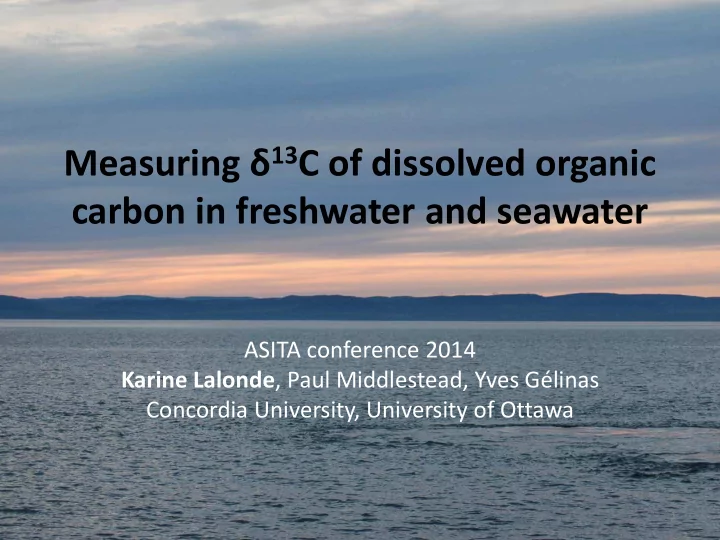

Measuring δ 13 C of dissolved organic carbon in freshwater and seawater ASITA conference 2014 Karine Lalonde , Paul Middlestead, Yves Gélinas Concordia University, University of Ottawa 1
The seawater DOC challenge • Large active pool of reduced carbon – (700 x 10 15 g OC) • For 1 L of seawater – 35g of salts – As low as 0.5mg OC 2
The evolution of seawater δ 13 C DOC [St-Jean 2003], [Osburn 2007] Wet oxidation [Beaupré 2007] V = 10-25mL UV oxidation [Williams 1968] 20 min V = 30-650mL UV oxidation Not automated 4-5 hours V = 1.8 L Not automated 6 hours HTC-DOC Not automated V = 5-10 mL 2003-2008 1992 20 min automated 1968 [Fry 1992] [Lang 2007], NOW lyophilization [Panetta 2008] V = 25 mL HTC-DOC 3 hours V = 5-10 mL Not automated 45 min Not automated
The old system CO 2 N 2 (L) CO 2 6 x 150 μ L injections 45 minutes Panetta (2008), Analytical Chemistry 4
The new system Electric Cue CO 2 CO 2 Electric Cue 5
CO 2 trapping system 6
Special thanks to Paul Middlestead Graham Hughes G. G. HATCH Laboratory Graden Instruments
Humm
Benefits of Automation • Fewer mistakes • Longer sequences – Higher throughput – More controls – More replicates – Better standard deviations – Better idea of system limitations/capabilities • Better relationship with your grad students./support staff
Dissolved organic carbon (DOC) analyzer: Water and salt traps IR detector 680 o C Sample To IRMS 10
CO 2 peak problems • Peak from the DOC • Peak requirements for analyzer: IRMS 1. Tails due to differing 1. Peak should be as combustion efficiencies narrow and as intense as possible 2. About 3 minutes wide 2. Peak must be in He gas 3. CO 2 peak is in Oxygen gas 11
CO 2 Trapping system CO 2 from DOC Heat to 250 o C 12
CO 2 Trapping system He gas IRMS O 2 +CO 2 from DOC O 2 + CO 2 He gas Not in use 13
CO 2 Trapping system He gas IRMS CO 2 trapped O 2 +CO 2 from DOC Clean O 2 O 2 + CO 2 He gas Not in use 14
CO 2 Trapping system He gas IRMS CO 2 trapped O 2 +CO 2 from DOC Removed O 2 O 2 + CO 2 He gas Not in use 15
CO 2 Trapping system He gas IRMS CO 2 trapped Trap is heated to 250 o C O 2 +CO 2 from DOC O 2 + CO 2 He gas Not in use 16
It works!! 17
DOC –IRMS δ 13 C DOC –IRMS δ 13 C true δ 13 C values Sample PAUL ConU (‰) (‰) (‰) Sucrose (In-house) -11.77 -12.1 ± (NA) -11.6 ± (0.2) KHP* -28.16 -27.8 ± (NA) -28.1 ± (0.2) β -Alanine -26.18 -25.3 ± (NA) -26.1 ± (0.2) Suwanee river fulvic acid -27.60 -27.4 ± (NA) -27.8 ± (0.2) Deep Florida Straight water ? -20.6 ± (0.3) -19.9 ± (0.5) *KHP = potassium hydrogen phthalate No matrix effects Little to no carry over from the combustion column
How low can you go? 0.9 0.8 Standard deviation (‰) 0.7 High blank contribution 0.6 0.5 Low blank 0.4 contribution 0.3 0.2 0.1 0 0 2 4 6 8 10 12 Concentration (ppm)
Where does the blank come from? • The blank comes from the column packing CO 2 • δ 13 C of the blank is between -20 & -12‰ • Pretty constant intensity and signature over one sequence • Variable over many sequences – Must be corrected before running samples
Accounting for the blank 1/MH (nA -1 ) -4 0 0.1 0.2 0.3 0.4 0.5 -8 -12 raw δ 13 C (‰) Sucrose (-10.47‰) -16 β -Alanine (-26.18‰) -20 KHP(-28.16‰) -24 -28 δ b = (Slope / η b ) + δ bc IRMS blank intensity
Testing combustion efficiency sucrose, δ 13 C = -10.5‰ KHP, δ 13 C = -28.2‰ Enriched algae δ 13 C = +11.6‰ Incomplete combustion results in δ 13 C shifts Incomplete combustion results in no δ 13 C shifts 100% combustion δ 13 C = -9 ‰ δ 13 C always = -10.5 ‰ 5% of KHP is not combusted = -7.6 ‰
DOC system pressure and combustion System pressure (PSI) 20 25 30 -4 -5 -6 -7 δ 13 C (‰) -8 KHP/algae mix = -9.0‰ -9 -10 IAEA sucrose = -10.5‰ -11 -12
Injection volume and combustion Injection Volume ( μ L) 1500 1200 750 500 -5 -6 -7 δ 13 C (‰) -8 -9 KHP/algae mix = -9.0‰ -10 IAEA sucrose = -10.5‰ -11 -12
Seawater.. Is it possible? • Matrix does not affect combustion efficiency • Low concentration of seawater DOC are problematic – Lowest possible standard deviations are ± 0.5‰ at 0.5 ppm • See Andrew Barber’s poster tonight!
δ 13 C signature in the SLE (‰) Salinity (psu) 26
Acknowledgements Yves Gélinas Technical Help and Others Alfonso Mucci • Anssi Vähätalo Committee members • Paul Middlestead (University of Ottawa) • Xavier Ottenwaelder • Graham Hughes (OI technologies) • Cameron Skinner • Alain Tessier (CBAMS) Lab members • Richard and Aldo (Machine shop) • Andrew Barber • Dan (Electronics Shop) • Mina Ibrahim • Alexandre Ouellet • Anja Moritz • Rob Panetta 27
Recommend
More recommend